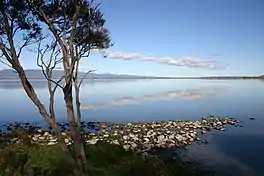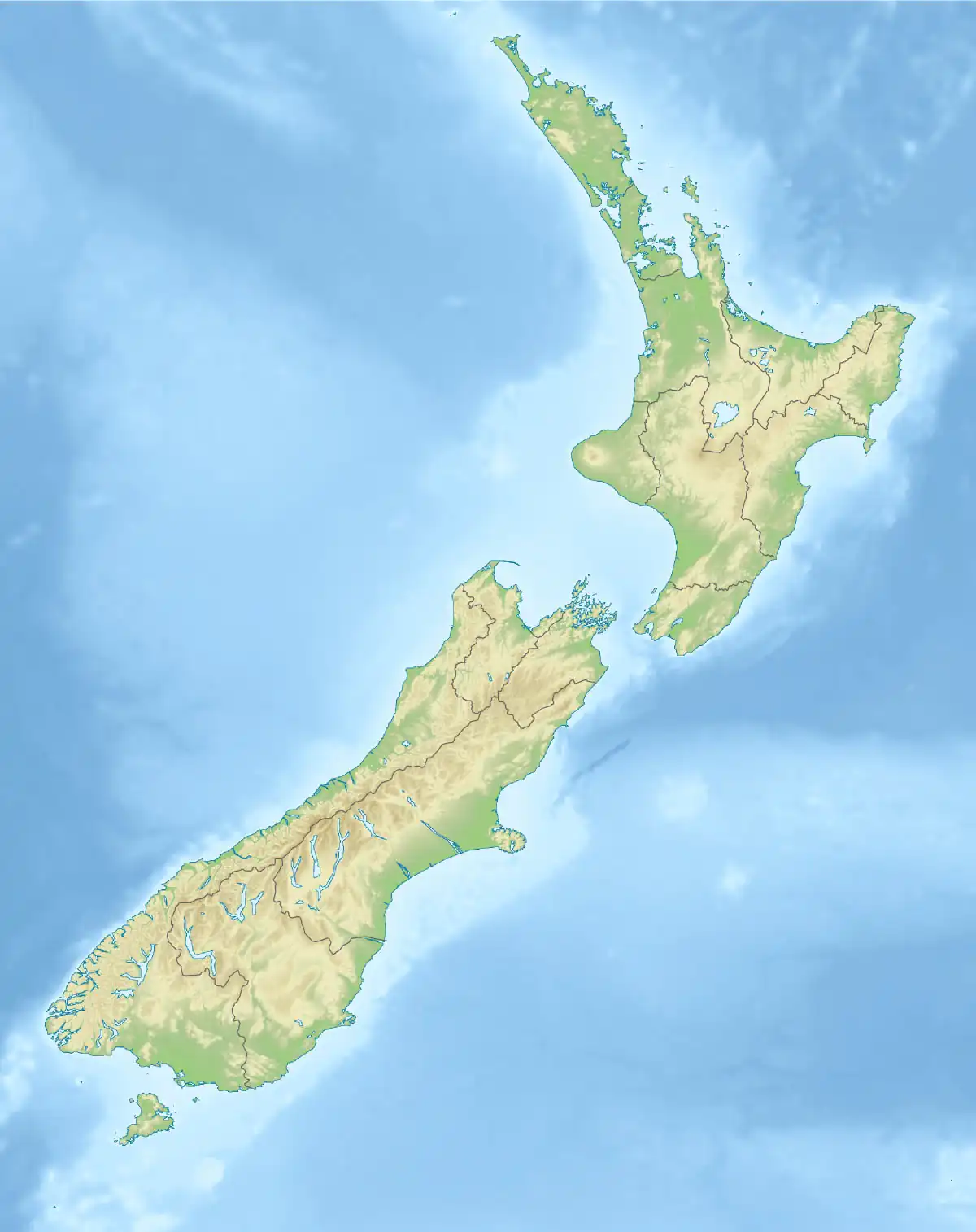| Lake Wairarapa | |
|---|---|
 Western shore looking south | |
 Lake Wairarapa Lake Wairarapa is in the Wellington Region of the North Island. | |
| Location | South Wairarapa District, Wellington Region, North Island |
| Coordinates | 41°13′S 175°15′E / 41.217°S 175.250°E |
| Primary inflows | Ruamahanga |
| Primary outflows | Ruamahanga |
| Basin countries | New Zealand |
| Surface area | 78 km2 (30 sq mi) |
| Max. depth | 2.5 m (8 ft 2 in) |
| Settlements | Featherston |
| Official name | Wairarapa Moana Wetland |
| Designated | 20 August 2020 |
| Reference no. | 2432[1] |
Lake Wairarapa is a lake at the southern end of the North Island of New Zealand, 50 kilometres (31 mi) east of Wellington. The lake covers an area of 78 km2 (30 sq mi), and at its deepest is 2.5 m (8.2 ft).[2] It is the third largest in the North Island, fractionally smaller than Lake Rotorua. The nearest town to the lake is Featherston, which is located five kilometres from its northern shore.
The lake forms part of the Wairarapa Moana Wetlands, a regional park administered by Wellington Regional Council, in collaboration with Kahungunu ki Wairarapa, the Department of Conservation, South Wairarapa District Council, and Rangitāne o Wairarapa.[3][4] The wetland is the largest in the lower North Island, one of the largest in New Zealand, and was recognised as a wetland of international significance under the Ramsar Convention in August 2020.[5]
Geography
The lake's catchment area is large, and includes the eastern slopes of the Remutaka and Tararua Ranges. The lake takes water from several rivers and was originally the main outflow for the Ruamahanga. This in turn drained slowly into Palliser Bay and Cook Strait ten kilometres south near the settlement of Lake Ferry, via what is now Lake Onoke. The river, however, was diverted in the 1960s to assist flow, thereby reducing flooding for farmers. The lake today therefore covers an area significantly smaller than its historical size of around 210 km2 (81 sq mi).[6]
The area around the lake is low-lying and swampy, and recent efforts have been made to preserve its important wetland features and restore wildlife habitat that has been degraded through human use. Agriculture and river development, flood control, and waterway diversions have resulted in the drainage of large areas of the wetlands, reducing their ecological values.[7]
Lake Wairarapa is classed as supertrophic on the trophic level index, meaning that it is highly polluted with nitrates which leach from intensified agriculture surrounding the lake.[8] This is in line with the wider trend of agriculture polluting New Zealand rivers and lakes.[9]
History
The name Wairarapa means "glistening waters" in te reo Māori. According to some oral histories, the Polynesian explorer Kupe named the wetlands after touching down in the area several times. According to other oral histories, explorer Haunui named the wetlands after the way the lake appeared to glisten from the Remutaka Ranges to the west.[10][11]
The lake has long been used by Māori as a source of readily available food, and many species of waterfowl and fish uncommon elsewhere in New Zealand can be found in or around the lake.[12]

See also
References
- ↑ "Wairarapa Moana Wetland". Ramsar Sites Information Service. Retrieved 25 September 2020.
- ↑ "Lake Wairarapa & Wairarapa Moana". Destination Wairarapa. Retrieved 25 September 2017.
- ↑ "Wairarapa Moana Wetlands Park". Department of Conservation. Archived from the original on 17 February 2013. Retrieved 18 February 2013.
- ↑ "Wairarapa Moana Wetlands". gw.govt.nz. Wellington Regional Council.
- ↑ Fuller, Piers (21 August 2020). "'A lake worth saving': Wairarapa Moana named 'a wetland of international significance'". Stuff. Dominion Post.
- ↑ Flack, J: Wairarapa Times Age, Feb 2000.
- ↑ NZ Department of Conservation
- ↑ "100 years to clean up our lake – Times Age". Times Age. 27 June 2017. Retrieved 25 September 2017.
- ↑ "River ecologist: 'It's a really bad situation'". Stuff. Retrieved 25 September 2017.
- ↑ Yerex, David (1991). They Came to Wydrop: The Beetham and Williams Families of Brancepeth and Te Parae, Wairarapa, 1856–1990. ISBN 9781869560249.
- ↑ Smith, Sophronia. "Ko ngā kōrero taketake o Wairarapa Moana". waiwetlands.org.nz. Wellington Regional Council.
- ↑ "Lake Wairarapa & Wairarapa Moana". wairarapanz.com. Destination Wairarapa.
External links
- Wairarapa Moana Wetlands Park at the Department of Conservation
- Wairarapa Moana Wetlands Project official website